This is not really very profound but I think it is an interesting thing to look out for.
I think there are
grammars of place, some of which are highly set in cultures and others which emerge over time.
An example of a highly rigid grammar of place is the way we set out our tables for eating with knives and forks, glasses etc positioned, there is right and wrong, evolved over time. It is based on etiquette and a notion of aesthetics.
The way the place is set up influences behaviour of those who interact with the place, those who 'enter the scene'. (There is always a sense of Drama and of 'scene by scene' at a dinner party.)
There is also the kind of grammar of place which is to do with arranging stuff in sets; such as we always see in shop displays,
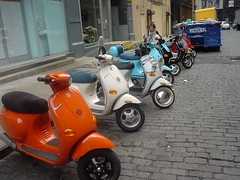
or even spontaneously, the way people park ther cars or bikes in syntactical arrangements.
Somehow I find myself reading such displays from left to right and across then down the rows. Things are organised in groups, like lexical sets.

When things are not neat and in rows we are quite surprised. This chaotic pile of broken dolls looks like carnage; it is quite a challenge to our sense of order and it reads in a particular way I think.
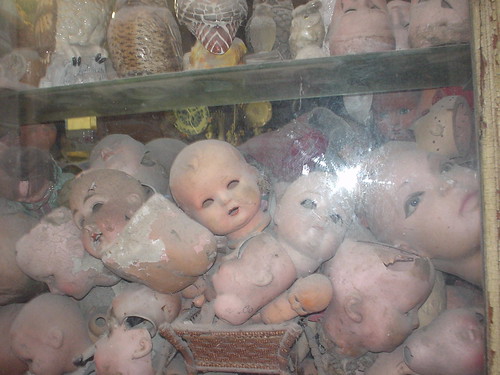
Sometimes , places beocome texts because of the writing we put in the place and this writing starts to actually consitute the place, even controlling behaviour - an obvious example being marks on the road, traffic signs etc.
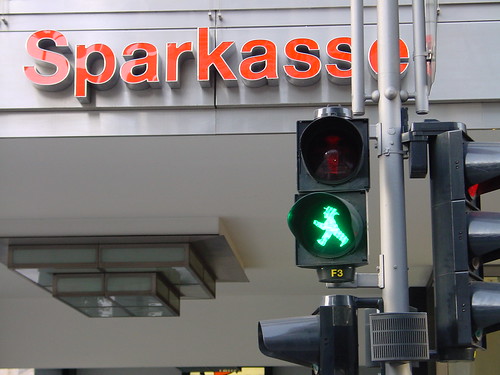
(This crossing sign is additionally interesting as the 'Ampelmann' is from East Germany and is a collectors' item!)
Sometimes the writing is just IN the place and does not quite turn the place into a text I don't think. But in the example below, a section of the Berlin wall is used to display pieces of information about Nazi Germany and the Cold war. It is both 'text in place' and 'place as text'.

The way we read a place or a text can change over time - such as the Roman Colosseum or Forum. Now we see the forum as an artefact, as a historical text. We read it for clues about previous lives but also it stands as Rome today; Rome as a place to read.
I have already shown (as has Guy) the way houses have become texts over the Christmas period, linking out to other signs to do with Christmas, and linking with other houses that do the same.
My thing on Parkour showed the cityscape being used in different ways, thus revealing the cultural constraints we unconsciously presume about the way we should use the environment - we have notions about the right and wrong way to travel round places. If we involve ourselves in free running, we begin to see Place as Playground, or as something with a range of affordances or potential, waiting to be discovered. Freerunners unsettle and redefine our notions of urban environments and we can begin to read it differently. We interact with it in new ways.
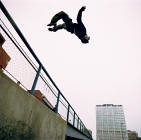
And finally, light heartedly, we can change the way we read a place by the way we behave in it. Here is my sister as a Charlie's Angel, running in front of a church doorway, transforming holy place to an intertextual reference.
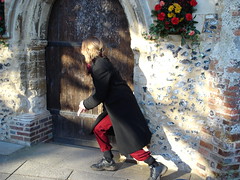
Can we descibe all this as urban tapestry?
And is my blog a place?


5 comments:
Interesting and I think worthy of more exploration. In particular what about the deliberate subverting of place as text; Larry Sultan has explored the home as signifier. Most recently he has peered into that most invasive form of late capitalism, the home as factor of production.
His ‘The Valley series focuses on the San Fernando Valley, where he grew up, and addresses the use of ordinary homes as sets for pornographic films. In Sultan’s large-scale colour photographs, mundane objects — a roll of paper towels, a stack of dirty dishes — take on new weight, and suburban life becomes a symbolically charged backdrop. The project investigates the meaning of home and asks why the ideal of middle-class domesticity lends itself to this most curious form of cultural appropriation’. (San Francisco Museum of Modern Art)
See some more here
http://www.billcharles.com/sultan/sultan_7.htm
Read more here
http://www.suspectthoughts.com/sultan.html
Meanwhile none of this academic musing will keep Chemistry Departments open
Kim Howls
You have certainly been doing your homework Kim.
Thanks for this.
OMG
Glad you think this is interesting ...
It relies of course on a broad concept of space which relates to cultural definitions and social conventions too.
I think that every culture designs spaces with their own conventions - and you can accidentally break some of the rules - a bit like getting the grammar wrong.
Leander and MCkim (I have only just now read,) say that ' The ability of texts to create social spaces is not uniqure to online practices.' And as you see, I do agree with them!
So exciting, as you say!!
Why does your sister have her trousers tucked into her socks? I'm sure Charlie's angels didn't do that. Perhaps it's a polytextual reference to cycling AND C's A's AND churches. Do you know of any nice young men who are interested in getting intertextual?
Stop dissing my sis, she has Special needs.
And getting intertextual with men is fine, so long as you use full stops.
Post a Comment